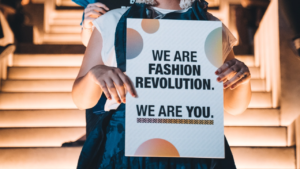After “flight shame” and “heat shame”, is “ordering shame” coming?
Long queues at checkouts? Gone. Ordering around the clock from the comfort of your own four walls is the new normal. And how practical, the best thing is to order the coveted item in several sizes and colours; what you don’t like is sent back. This buying behaviour is called “bracketing”. In so-called bracketing (roughly: buy and try), it looks like this: customers order an item in varied sizes and versions. They do not intend to keep all the product variants they have ordered but order to return sizes or variations to the retailer that do not fit.
Thanks to generous and customer-friendly regulations – Zalando, Amazon and Otto, to name just three of the big players, pay the return postage – customers use this service excessively.
When asked how they planned to cope with the never-ending flood of order returns in the future, a high-ranking member of the management at one of the most successful platforms for fashion answered succinctly: “The customer journey on our platform will continue to be an exceptional user experience, even as we strive to live up to our responsibilities!”
What sounds like unwieldy marketing slogans could, critically, also be interpreted as “business as usual”. But especially in times when Generation Z is demanding real sustainability concepts, the topic of returns is becoming the Achilles’ heel of e-commerce for online retailers.
After “flight shame” and “heat shame”, is there now a new wave called “ordering shame”? What happens to the goods ordered carelessly and finding their way back to the supplier? How sustainable are these practices?
Platforms and sustainability – an oxymoron?

© Francois Le Nguyen / Unsplash
One of the biggest problems with returning items is the high waste of resources and energy. The transport and storage of returned goods generate significant CO2 emissions. According to a study by the Institute for Energy and Environmental Research (ifeu) in Heidelberg, about 238,000 tonnes of CO2 are emitted by returns in Germany annually- corresponding to the annual CO2 emissions of about 60,000 cars. This is not to the liking of environmentally conscious customers.
But there is light at the end of the tunnel – the online fashion platform Zalando has recognised the signs of the times and reacted. Since 2019, the company has been focusing more on sustainable returns management. For example, returned goods are now processed, sorted, and, if necessary, repaired in special sorting centres. This means they can be offered for sale again and do not have to be disposed of. Zalando has also launched a project called “Pre-owned”, where used clothes are sold. These measures show that the company is trying to improve its ecological balance. At least, it is trying. Even if the company is currently dominating the headlines because of a greenwashing scandal:
Zalando’s Greenwashing scandal

© Zalando
The online fashion retailer Zalando is undisputedly the largest in Europe. In 2021, the company recorded well over 250 million orders – impressive figures. Still, with a negative aspect: About half of these orders are returned. Almost 50% returns! This means not only logistical challenges, but also a considerable environmental burden. However, Zalando advertises that it is becoming a sustainable fashion platform with a “net positive impact on people and the planet”. Thus, returns and deliveries are also to be made climate neutral.
On its homepage, Zalando further states that 97 per cent of returned garments are “resold via the Zalando Shop after appropriate inspection and careful refurbishment”. The rest is sold in Zalando outlets, in the Zalando Lounge, or donated to organisations. According to Zalando, only less than 0.05 per cent of returns is destroyed “in exceptional cases”, for example, if they are contaminated or infested with pests. But does Zalando keep this promise?
The team of the SWR investment format VOLLBILD in long-term research investigated this question. In August 2022, VOLLBILD reporters ordered ten items of clothing into which they had GPS and Bluetooth trackers sewn and then sent them back to Zalando. They followed the routes of the trackers for months, and found out that some returns travel long distances all over Europe. This indicates that the returns’ logistics are not as sustainable as Zalando promises on its homepage. The editors of the ARD magazine Report-Mainz even speak of deceiving customers!
The investigation by the VOLLBILD team thus clarifies that there is still room for improvement in the sustainability of return logistics. Whether Zalando will pursue these improvements remains to be seen. What is clear, however, is that the sustainable use of resources and responsible action are essential in times of climate change.
“Green” product line Aware: Is Amazon greenwashing?

© Amazon
Another example is the online giant Amazon, which says it has set itself to be climate neutral by 2025. The company has taken various measures to reduce CO2 emissions from returns in this context. For example, Amazon offers its customers to return items within the framework of the “Shipping by Amazon” programme. Here, the items are transported in specially designed containers that can be reused several times. In addition, returned items are inspected, repaired, and resold as part of the “Amazon Renewed” programme.
However, this has attracted critics who call these measures greenwashing and point out that most returned goods are still disposed of. According to a 2019 study by the University of Bamberg, only about 20 per cent of returned clothing in Germany is reused or repaired. The rest is destroyed or exported – often to countries with significantly lower environmental standards than Germany.
Sustainable returns management in the responsibility of consumers

© Pexels
So, there is still much to do to make returns management more sustainable. An actual start could be encouraging customers to carefully order and choose only the needed items. In addition, platforms could create incentives to change customers’ return behaviour by introducing return fees. However, it is also essential that the responsibility for sustainable returns management lies with the platforms themselves and consumers. Suppose everyone is more conscious about their purchases and returns. In that case, an important contribution to environmental protection can be made together.
In this sense, online shoppers should not only pay attention to a quick and easy return, but also include the topic of sustainability in their purchasing decisions. Various aspects, such as material quality, production conditions or transport routes, can be considered. Overall, the topic of sustainability in return management is increasingly coming into focus. There are already initial positive approaches for the platforms, but these can be further expanded. Consumers also have a significant role to play here. They can contribute to reducing the ecological footprint of online shopping through more conscious consumer behaviour.
How could the return rate be reduced?

© Adrian Sulyok / Unsplash
Some measures companies can take to reduce the number of returns significantly are:
- Improved product descriptions! A detailed presentation can help customers choose the right product and thus result in fewer returns.
- As trivial as this may sound, deliver that for which is being searched. Especially with product images that raise false expectations, returns increase. The scope of delivery should be accurately depicted, both in terms of colour variants and the number of products.
- Sustainable packaging: Companies can use sustainable packaging to reduce environmental impact.
- Fast fulfilment: Long delivery times or subsequent delays often lead to customers cancelling and refusing to accept goods that have usually already been shipped.
- Returns fees: Companies can introduce return fees to reduce the number of returns. However, they are still reluctant to do so, fearing this will lead to a massive drop in orders.
Returning products is an environmental problem for online retailers and means high costs. For this reason, some companies have already developed strategies to overcome this challenge.
The US company Mysize, for example, has developed its measuring technology to help customers find better-fitting clothes and products online. Artificial intelligence and machine learning determine the right size for each customer individually. This is intended to avoid incorrect purchases and bracketing, and thus reduce returns.
On the other hand, the fashion label Fashion Nova has developed a different strategy to reduce returns. Instead of a refund, the company offers its customers a voucher for its online shop in case of a return. The idea is to encourage them to order other products instead of returning them. This should benefit both the environment and the company.
These two examples show that there are indeed ways to reduce the number of returns and thus reduce the environmental impact. Although these strategies may lead to more effort for businesses, they can be worthwhile eventually and help make online shopping more sustainable.
How will returns develop in e-commerce in the future?

© Pexels
It is not necessary to look into the crystal ball to predict a trend for the near future because one thing is clear:
Nowadays, returns are simply part of online shopping. But what happens to the returned products, and how do they affect the environment? The CEO of ZigZag, Al Gerrie, provides some interesting insights.
According to Gerrie, almost half of the shoppers (48 per cent) now consider the environmental impact of returns and try to send fewer back. Furthermore, 42 per cent of consumers would return fewer products if they knew they would end up in the rubbish. So, awareness of a more sustainable world is growing increasingly.
But how can retailers meet their customers’ wishes while reducing the environmental impact of returns? According to Gerrie, they need to inform their customers better and offer them more flexibility and options for sustainable returns. One example of this is paperless returns solutions with QR codes.
However, there is one aspect that customers do not want to compromise on: cost. According to Gerrie, 41 per cent of customers would not want to pay more for a more sustainable return. This is a challenge for retailers if they want to reduce their environmental impact and retain or increase their customers simultaneously.
The days when environmental protection and commercialisation were incompatible are long gone. Today, more than ever, retailers must take responsibility for the environment seriously and offer their customers sustainable solutions. This is the only way they can be successful in the long term and, at the same time, contribute to the protection of our planet.







